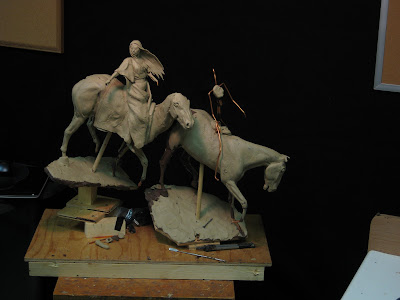The following took both today and yesterday to complete. Again, click on the photo's to view larger versions of them.I'm at the final steps of this clay. I've added beaded necklaces and hairpiece. While doing my research I found that many of the plains Indian Woman wore not only necklaces and hair ornaments, they wore bracelets and rings. Not sure if Sacagawea would have. I'm taking a bit of artistic licence.
I start working on the Deer Doe tail on the front of her dress. Adding fur texture. I heat the tool with a lighter and then while it's warm, work the clay. This lightly melts the clay and allows the tool to move through the clay without having it sticking to the tool.
The last photo in the series below, you can see, I'm using a lighter to melt the surface of the shell ornament in her hair. This shines the clay and gives it a higher polished surface.
(If you are a minor, do not do this without your parents supervision) 
Next I try and take down the sharp edges of the fur texture I've created. The way I do this, I use lighter fluid on a paintbrush. The lighter fluid melts the clay a little and thus changes the texture. (Again, if you are a minor, do not do this without your parents supervision)

Now I need to smooth the texture of the girls skin. Using a plastic kitchen Brillo, I squirt lighter fluid on it, then on the face. I then start to rub the skin, careful not to overdo it.

Then doing the same using different brushes, I continue to smooth the skin surface.
I use my thumb to smooth it even more.
Now here's where if your a minor, do not do the following at all.
Using a small torch, I melt the surface of the skin. This gives the skin a high gloss. You have to be really carefull doing this. You can hit the skin with to much heat and melt more than you want to.

Below are the final photo's of this clay. Monday, I'll take it to Bozeman to a foundry to get an idea as to how expensive this piece will be to cast into bronze. The cost of production will determine the selling price I ask for the finished bronze of this new piece.


Finally, no one really knows the exact date Sacagawea was born or the exact date she died. Sacagawea's, known history begins at the age of 12 when she was kidnapped by a war party of Hidatsa Indians. This took place 40 miles north of where I live here in Montana.
She was taken from her homeland located in today’s Idaho and Western Montana, to the Hidatsa-Mandan villages near what is know known as Bismarck, North Dakota. There, she was later sold as a slave to Toussaint Charbonneau, a French-Canadian fur trader. In November 1804, the Corps of Discovery arrived at the Hidatsa-Mandan villaage. The corps decided that Sacagawea would could be very important to the expedition becuase of her Shosonne roots. So they hired Sacagawea and her husband Toussaint Charbonneau as translaters. Sacagawea did not speak English, but she spoke Shoshone and Hidatsa. Her husband Charbonneau spoke Hidatsa and French. So the plan was if they met the Shoshones, Sacagawea would talk with them, then translate to Hidatsa for Charbonneau, who would translate to French. Then the Corps’ Francois Labiche would translate the French into English so the captins would understand. Sacagawea turn out to be important not just for her translating. When Indian tribes saw the expedition with a woman and a child they new it was a friendly party not a war party.
Well that's it for now. Check back in next week. I'll be revisiting an earlier clay.




















































